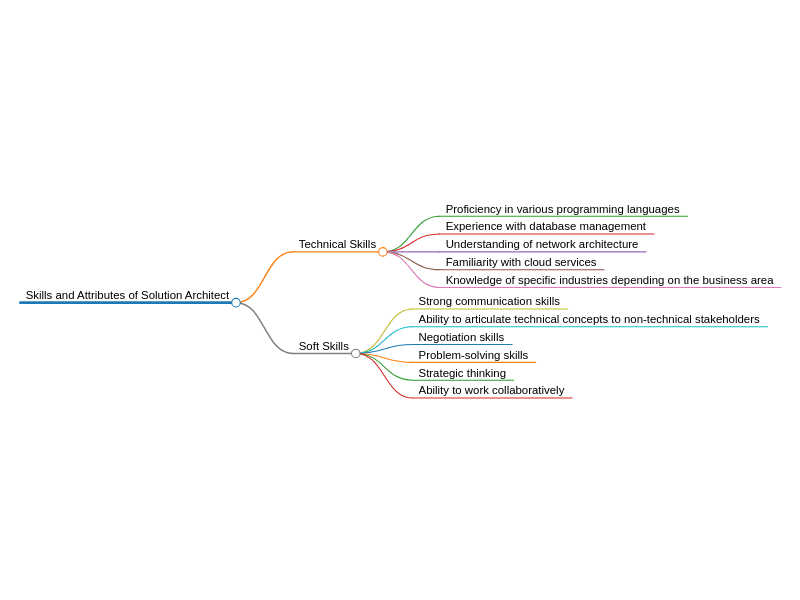As organizations navigate the complexities of digital transformation, the role of Solutions Architects has become increasingly critical. According to a report by the International Data Corporation (IDC), global spending on digital transformation is expected to reach $3.4 trillion by 2026. These professionals bridge the gap between a company’s technological capabilities and its strategic business goals, ensuring that the technology employed not only supports but enhances business operations.
What is a Solutions Architect?
A Solutions Architect is a pivotal role in the technology sector, serving as the linchpin that connects a company’s operational needs with suitable technological solutions. These architects analyze business requirements and craft architectural solutions that are scalable, sustainable, and aligned with the company’s goals. Their work is crucial in avoiding costly mismatches between technology and business objectives, thereby enabling companies to maximize their return on investment in technology.
Role Overview
In modern business environments, Solutions Architects are at the heart of strategic initiatives involving digital transformation and technology integration. Their role is strategic, not just operational; they are involved in designing systems and solutions and guiding senior management on technological trends that could impact future business landscapes. As catalysts of change, Solutions Architects play a vital role in ensuring that businesses stay agile and responsive to market dynamics by leveraging technology effectively.
A Solutions Architect is primarily responsible for the design and implementation of specific technological solutions that support business objectives. This role involves a deep understanding of both the company’s needs and the technological landscape to create systems that are efficient, scalable, and forward-thinking. The importance of a Solutions Architect lies in their ability to translate complex technical requirements into actionable architecture that aligns with business goals, ensuring technology adds value rather than complexity to the organization.
How do Solution Architects Different From Other Architects?
While the Solutions Architect is a critical role, it is one of several within the architecture domain of IT. It is important to distinguish it from roles such as Enterprise Architects and Technical Architects. Each role has distinct responsibilities and focus areas, contributing uniquely to the organization’s objectives.
Role Comparisons
Solutions Architect: Focuses on solving specific business problems through technology solutions. They design and implement systems directly aligned with strategic business objectives for particular projects or components. This role is highly project-centric, often working closely with project managers and development teams to ensure that the technical solutions are appropriate for the intended business outcomes.
Enterprise Architect: Operates at a higher level of abstraction, focusing on the overarching IT infrastructure and strategic alignment across the entire organization. They develop and maintain a cohesive technology environment that supports the organization’s long-term goals. Their work includes defining technological standards and procedures that govern the entire organization’s IT practices.
Technical Architect: Specializes in specific technologies or platforms. Their role is to design the architecture for a particular system or set of systems, focusing on technical requirements and capabilities. They often work on the nuts and bolts of system development and are crucial when deep technical expertise is needed to solve complex technical challenges.
Interactions and Overlaps
These roles often overlap and require collaboration:
- Solutions and Enterprise Architects often work together to ensure that project-specific solutions fit within the larger strategic framework set by the Enterprise Architect.
- Solutions and Technical Architects collaborate to translate high-level architectural designs into detailed technical specifications and implementations.
This collaboration ensures that while individual projects are effectively supported by technology, they also align with the broader business strategy and technology framework of the organization. Understanding these roles helps clarify the unique contributions of a Solutions Architect, which centers on bridging the gap between strategic business outcomes and practical, effective technology solutions. This nuanced approach enables tailored technology solutions that propel businesses forward.
What Does a Solutions Architect Do?
Solutions Architects are pivotal in shaping the technology landscape of an organization, ensuring that the architectural solutions designed are robust, scalable, and aligned with business objectives. The Bureau of Labor Statistics (BLS) projects that employment for computer and information systems managers, including Solutions Architects, will grow by 10% from 2019 to 2029 . Their role encompasses a blend of technical acumen and strategic foresight.
Daily Responsibilities of Solution Architect

As you can see, the day-to-day tasks of a Solutions Architect are diverse, reflecting the multidisciplinary nature of the role. Key responsibilities include:
- Designing Architectural Solutions: Crafting detailed architecture plans that address specific business needs while considering scalability, security, and integration with existing systems.
- Stakeholder Interaction: Regularly communicating with various stakeholders, including business leaders, project managers, and technical teams, to ensure that the architectural designs meet business goals and are technically viable.
- Project Oversight: Overseeing the implementation of architectural solutions, ensuring that the deployment aligns with the designed architecture and business expectations.
- Technical Guidance and Support: Providing expertise and support during the solution development lifecycle from conception through to deployment and beyond.
Strategic Role
Beyond their day-to-day tasks, Solutions Architects exert significant influence on the technological direction of a company. They:
- Align Technology with Business Strategy: Ensure that the technology solutions not only fit the current needs but are also adaptable to future changes in business strategy.
- Innovate and Advocate for New Technologies: Research and advocate for adopting new technologies that can provide competitive advantages.
- Risk Management: Identify potential technical risks in projects and develop mitigation strategies.
- Cost Management: Balance between the best technical solutions and budgetary constraints, optimizing cost without compromising functionality.
This strategic involvement makes Solutions Architects key players in not only shaping the immediate technological implementations but also defining the broader technological future of the organization. A survey by McKinsey found that organizations with successful digital transformations were 1.5 times more likely to report financial outperformance compared to peers .
Enhance Your Tech Team
Get your solution architect onboard in one week or less.
How to Become a Solutions Architect
For those aspiring to the role of a Solutions Architect, the path is marked by a combination of education, practical experience, and the development of a specific set of skills. This journey involves understanding the intricacies of technology and its application in a business context.
Educational Background
Most Solutions Architects start with a foundational education in computer science, information technology, software engineering, or a related field. A bachelor’s degree in one of these disciplines provides the technical groundwork necessary for understanding complex technical concepts and systems. However, given the role’s integration with business processes, additional education in business management or similar fields can be advantageous. Some professionals further their qualifications with master’s degrees in information systems, business administration (MBA), or specialized IT fields, which can provide a deeper understanding of the nexus between technology and business strategy.
Career Progression
Career progression to becoming a Solutions Architect typically starts with gaining substantial experience in more technical roles. Entry-level positions might include software development, system engineering, or technical support, where practical skills are developed and a strong understanding of technology is established. As one progresses, roles such as Senior Developer or Technical Lead provide opportunities to undertake greater responsibility in designing solutions and leading projects.
Moving into a Solutions Architect role often requires not just technical expertise but also experience in project management and strategic planning. These experiences help in understanding how to align technology projects with business objectives effectively.
Skills and Attributes
The successful Solutions Architect will possess a blend of technical and soft skills:
Technical Skills: Proficiency in various programming languages, experience with database management, understanding of network architecture, and familiarity with cloud services are fundamental. Knowledge of specific industries can also be crucial depending on the business area of the organization.
Soft Skills: Strong communication skills are essential to articulate technical concepts to non-technical stakeholders and to negotiate the often competing interests of various business departments. Problem-solving skills, strategic thinking, and the ability to work collaboratively are also critical.
By building on these foundational elements—education, career experience, and skill development—prospective Solutions Architects can position themselves effectively for this strategic and impactful role.

Solutions Architect Certification
In the rapidly evolving field of IT architecture, professional certifications are valuable tools that can enhance a Solutions Architect’s qualifications, credibility, and career prospects. These certifications not only validate the individual’s expertise in specific technologies but also demonstrate a commitment to professional development.
Certification Benefits
Certifications in solution architecture provide numerous benefits:
- Professional Credibility: Certifications are often recognized industry-wide and add significant credibility to a professional’s expertise, enhancing their profile in job markets and within their current organization.
- Skill Enhancement: These certifications ensure that the architect is up-to-date with the latest technologies, methodologies, and best practices in solution architecture.
- Career Advancement: Being certified can lead to better job opportunities, higher roles, and increased salary potential as it showcases an ability to handle complex architecture projects.
Popular Certifications
Several key certifications are recognized globally and are highly regarded in the industry:
- AWS Certified Solutions Architect: Offered by Amazon Web Services, this certification validates an individual’s expertise in designing scalable, elastic, resilient, and cost-effective systems on AWS. It is ideal for those working in environments that use AWS technologies.
- Microsoft Certified: Azure Solutions Architect Expert: This certification demonstrates expertise in designing solutions that run on Microsoft Azure, including aspects such as compute, network, storage, and security.
- Google Certified Professional Cloud Architect: This credential certifies that an individual can design, develop, and manage robust, secure, scalable, highly available, and dynamic solutions to drive business objectives on Google Cloud.
- Certified Solutions Architect – Professional (CSA-Pro) from the Cloud Credential Council (CCC): This certification is technology-neutral and focuses on essential principles for developing robust architectures in any cloud or hybrid system.
Each of these certifications requires passing rigorous examinations and, in some cases, having hands-on experience in the relevant technologies. They are designed to stretch the capabilities of the architect, ensuring they are well-prepared to handle the challenges of modern IT environments.
For Solutions Architects seeking to solidify their expertise and enhance their career trajectory, pursuing these certifications is a strategic move that aligns with continuous professional development and staying competitive in the field.
Key Processes in Solution Architecture
The practice of solution architecture involves several core processes that ensure the successful delivery of architectural projects. These processes range from the initial stages of requirement analysis to the ongoing maintenance and optimization of systems. Understanding these processes is essential for any Solutions Architect aiming to create effective and sustainable technology solutions.
Core Processes
- Requirement Analysis: This initial process involves gathering and analyzing the business requirements from stakeholders. It’s crucial for understanding what the stakeholders need from the technology solutions, ensuring that the architecture designed will meet these needs effectively.
- Solution Ideation and Design: Based on the requirements gathered, Solutions Architects conceptualize and design the architecture. This includes selecting appropriate technologies, defining system interfaces, and designing data flows and infrastructure.
- Solution Evaluation and Selection: Here, different architectural solutions are evaluated against criteria such as cost efficiency, scalability, and alignment with business goals. The best-fit solution is selected for implementation.
- Implementation Oversight: Solutions Architects oversee the implementation of the architecture, ensuring that it adheres to the architectural design and integrates smoothly with existing systems.
- Testing and Integration: Rigorous testing is conducted to ensure that the new system operates as intended. Integration testing is crucial to verify that the new system interacts correctly with existing systems.
- Maintenance and Optimization: Post-implementation, the focus shifts to maintaining and optimizing the system to ensure it continues to meet business needs as they evolve. This involves regular reviews and updates to the architecture.
Process Details
Each of these processes plays a critical role in the lifecycle of a technology solution:
- Requirement Analysis ensures that the solution addresses the actual needs of the business.
- Solution Ideation and Design involves creative and technical skills to devise systems that are not only effective but also innovative.
- Solution Evaluation and Selection requires analytical skills to assess various options and make informed decisions.
- Implementation Oversight demands project management skills to keep the implementation on track.
- Testing and Integration focuses on quality assurance and the seamless functioning of systems within the business’s tech ecosystem.
- Maintenance and Optimization is about long-term thinking and continuous improvement, ensuring the solution remains relevant and efficient.
By meticulously managing these processes, Solutions Architects ensure that technology solutions not only meet the immediate needs of the business but are also viable and efficient in the long term. This comprehensive approach to solution architecture enables businesses to leverage technology for strategic advantage.
When Do You Need Solution Architecture Consulting?
Solution architecture consulting is a specialized service that can provide significant benefits, particularly in scenarios where organizations face complex technological challenges or need to ensure that new tech initiatives align perfectly with business strategies. Identifying when to engage such consultants can make a crucial difference in project outcomes.
Consulting Scenarios
- Large-Scale Digital Transformations: When a company undertakes significant digital changes, such as moving from traditional IT infrastructure to a cloud-based environment, solution architecture consultants can provide the necessary expertise to design and guide the transformation.
- Mergers and Acquisitions: During M&As, integrating different technological systems can be complex. Consultants help ensure that the architectural solutions foster seamless integration and optimize performance across the newly formed entity.
- New Product Development: For launching new products, especially those heavily reliant on technology, consultants can design architectures that are scalable and robust, ensuring the product’s technology backbone is sound.
- Compliance and Security Projects: When businesses need to meet specific regulatory requirements or enhance their security posture, consultants can craft solutions that comply without compromising on efficiency or scalability.
Benefits of Consulting with Sphere
Sphere stands out as a premier consultant and provider in the realm of solution architecture, offering unmatched excellence and expertise that drive business success.
Expertise and Specialization
At Sphere, we bring specialized knowledge that is often not available internally within organizations. Our consultants are experts in the latest technologies and trends, ensuring your business leverages cutting-edge solutions for maximum impact.
Objective Perspective
As external advisors, Sphere provides unbiased recommendations that prioritize the best interests of your business. Our objective perspective allows us to deliver clear, strategic insights that align with your organizational goals without the influence of internal biases.
Risk Mitigation
Sphere’s consultants are adept at foreseeing potential pitfalls in projects and developing robust mitigation strategies. Our extensive experience and deep understanding of various industries enable us to identify risks early and implement measures to reduce them, ensuring smoother project execution and higher success rates.
Cost Efficiency
By offering expert advice on architectural design and implementation, Sphere helps businesses avoid costly mistakes and reworks. Our focus on efficiency ensures that your resources are used effectively, optimizing costs while delivering high-quality, functional solutions.
Your Strategic Value
Engaging with Sphere for solution architecture consulting is a strategic decision that enhances the success of specific projects and strengthens your organization’s overall technological capability. A survey by Deloitte indicates that 73% of businesses undergoing digital transformation have realized value from their initiatives within two years. This statistic underscores the importance of strategic consulting in achieving tangible business outcomes.
Our services are particularly valuable in ensuring that technology investments are made wisely, align with business goals, and contribute to long-term success. Sphere’s consultants are not just technical experts but strategic partners who guide your business through the complexities of digital transformation, ensuring that every technological investment delivers maximum return and supports your broader business strategy.
Conclusion
Throughout this exploration of the role of Solutions Architects, we’ve delved into their critical functions, the path to becoming one, the distinctions between related roles, and the vital skills required. Solutions Architects are indispensable in translating business needs into technological realities, ensuring that technology investments align strategically with business objectives and deliver tangible value.
Summary
- Role and Importance: Solutions Architects bridge the gap between business and technology, designing solutions that are not only technically sound but also strategically aligned with business goals.
- Becoming a Solutions Architect: The journey involves a robust educational foundation in technology and business, progressing through hands-on technical roles and developing a mix of technical and soft skills.
- Distinguishing Roles: Solutions Architects, Enterprise Architects, and Technical Architects play distinct but often overlapping roles within an organization, each contributing uniquely to the technological and business strategy.
- Skills and Certification: A combination of hard technical skills and soft interpersonal skills is essential, along with professional certifications that enhance credibility and career prospects.
Final Thoughts
The evolving role of Solutions Architects reflects broader shifts in technology and business landscapes. As organizations continue to navigate digital transformations, the demand for skilled Solutions Architects is likely to grow. These professionals not only contribute to the architectural design but also to strategic decision-making, positioning themselves as key drivers of business innovation and success.
For those aspiring to this career, understanding the depth and breadth of what the role entails and continuously adapting to new technologies and methodologies are paramount.
Solutions Architects are not just architects of systems but also architects of business transformation. This dual capability makes them invaluable as we advance further into a technology-driven future. If you want to find your Solution Architect, feel free to reach out to us via our Sphere query form.





